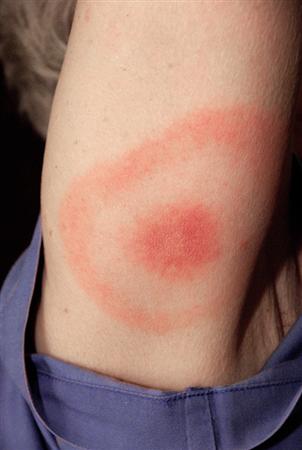Lymecare Alliance: Attaching Clients with Necessary Treatment Choices
Wiki Article
Lyme Illness Recognition Month-- Discover How to Secure Yourself
April is assigned as Lyme Condition Recognition Month, offering as an important suggestion of the importance of understanding and avoiding this progressively prevalent tick-borne disease. As we explore the nuances of Lyme condition, it comes to be clear that awareness is not simply concerning information; it is about taking purposeful activity to safeguard ourselves and our areas.Understanding Lyme Condition
Comprehending Lyme Disease starts with acknowledging its origins and transmission. This contagious disease is mainly triggered by the bacterium Borrelia burgdorferi, which is transmitted to human beings via the bite of contaminated black-legged ticks, generally referred to as deer ticks. These ticks flourish in wooded and grassy locations, making outside tasks a possible threat for direct exposure.The lifecycle of the tick is vital to comprehending exactly how Lyme Condition spreads (Lymecare Alliance). Generally, the ticks begin feeding in the larval phase, commonly acquiring the bacterium from small animals, such as rats or deer. As they create into nymphs or grownups, they can after that transfer the bacterium to bigger hosts, including human beings

Recognizing Signs Early
Early acknowledgment of Lyme Condition signs and symptoms is vital for efficient therapy and recovery. Lyme Condition, transferred primarily through the bite of infected black-legged ticks, can result in extreme complications otherwise attended to promptly. The first signs and symptoms usually show up within three to thirty days following a tick bite and may include fever, chills, exhaustion, muscle and joint pains, and swollen lymph nodes.One of the trademark signs of Lyme Illness is the characteristic erythema migrans rash, which resembles a "bull's- eye" pattern and generally emerges at the website of the tick bite. This breakout might not appear in every instance, making it vital to stay alert concerning other signs and symptoms.
People that have been in areas where Lyme Disease is native should be cautious and check their wellness closely after possible exposure. Recognition and education and learning concerning these early indicators are crucial in combating the influence of Lyme Condition.
Effective Avoidance Techniques
Avoiding Lyme Disease calls for a positive technique, particularly for individuals who frequent locations where ticks are common. Recognizing effective avoidance methods is crucial in reducing exposure to these useful content disease-carrying arachnids.First, it is necessary to wear appropriate clothing when in tick-infested environments. Long sleeves, long pants, and closed-toe shoes can significantly lower skin exposure. Think about treating apparel with permethrin, a bug spray that continues to be effective with numerous laundries.
Additionally, using a tick repellent having at the very least 20% DEET to subjected skin can further secure versus attacks. Routinely looking for ticks after outdoor tasks is crucial; execute extensive body inspections, particularly in warm, wet locations such as behind the knees and within the hairline.
Creating a tick-safe setting around your home is likewise advantageous. Keep your yard well-kept by mowing the grass consistently, removing ground cover, and creating barriers of crushed rock or wood chips to different wooded areas from leisure areas.
What to Do After a Bite
Instantly after a tick bite, it is critical to take swift activity to lessen the threat of Lyme Illness transmission. Pull upwards with steady, even stress; do not snag the tick or turn, as this may create parts to damage off and continue to be in the skin.Monitor the bite site for indicators of infection, such as redness, swelling, or a rash. It is necessary to be cautious for symptoms of Lyme Illness, which may consist of high temperature, chills, tiredness, and joint discomfort, usually showing up within 3 to thirty day post-bite. If you discover a characteristic "bull's- eye" breakout or experience any one of these signs and symptoms, seek medical focus without delay.
Notify your doctor of the tick bite, specifically if the tick was attached for even more than 24-hour or was engorged. If needed., early intervention is essential in protecting against the beginning of see page Lyme Illness and making certain effective treatment.
Resources for Further Info
Understanding the steps to take after a tick bite is necessary, but so is having accessibility to dependable sources for continuous education and learning regarding Lyme Condition. Numerous companies give comprehensive details to assist people remain educated regarding prevention, signs and symptoms, and therapy alternatives.The Centers for Condition Control and Prevention (CDC) uses a riches of resources, including standards on tick avoidance and details on Lyme Illness stats. Their internet site is a crucial starting point for anyone looking for expertise regarding the disease's effect and just how to alleviate threats.
Another valuable resource is the Lyme Illness Association, which concentrates on education and learning, campaigning for, and research (Lymecare Alliance). Their platform features short home articles, webinars, and updates on the latest clinical findings, making it a crucial tool for both individuals and medical care experts
In Addition, the American Lyme Disease Foundation offers academic products customized for various audiences, consisting of caretakers and outdoor lovers. They also host area occasions that advertise recognition and prevention strategies.
For those seeking assistance, organizations like the Tick-Borne Disease Partnership deal resources for getting in touch with neighborhood support system and accessing patient-centered care. Making use of these resources can empower people to secure themselves and their neighborhoods successfully.
Final Thought

The lifecycle of the tick is crucial to comprehending how Lyme Condition spreads (Lymecare Alliance).The threat of Lyme Disease increases throughout warmer months when ticks are most active, particularly in regions where the disease is endemic, such as the Northeast, Midwest, and parts of the West Shore of the United States. Lyme Illness, transmitted mainly with the bite of infected black-legged ticks, can lead to extreme issues if not resolved immediately.Quickly after a tick bite, it is critical to take speedy action to lessen the threat of Lyme Illness transmission. Understanding Lyme illness, recognizing its symptoms, and implementing effective avoidance strategies can substantially reduce the threat of infection
Report this wiki page